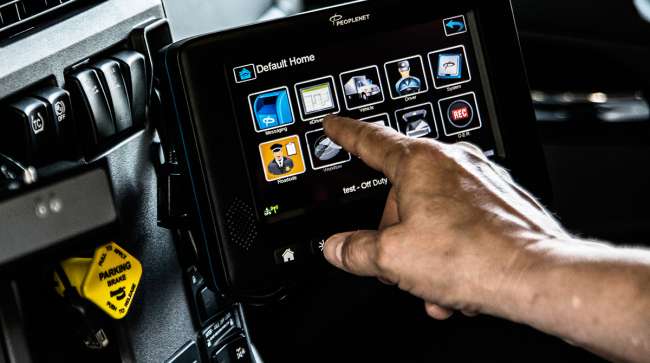ELD Compliance Rises, but Training, Enforcement Still Problematic

Compliance with a federal mandate to use electronic logging devices to record driver hours of service is on the rise, but the rollout is causing challenges for some carriers and drivers.
Some trucking executives say they are dealing with defective devices and software integration issues, while some drivers and safety enforcement personnel are still learning how to handle new paperless systems. Plus, a contingent of truck operators appear to be holding out until the end of a soft enforcement period to decide whether to quit the business or to comply with the ELD rule.
The ELD mandate took effect Dec. 18, but won’t be strictly enforced until April 1. Interviews with ELD vendors, carrier executives and other industry observers paint a mixed picture of compliance so far.
YOUR GUIDE TO THE MANDATE: Downloadable PDF.
A weekly survey by CarrierLists, a company in Tulsa, Okla., that markets carrier data to shippers and freight brokerage firms, shows ELD compliance rising from as little as 23% in September to 86% in its latest survey of 318 carriers the week of Jan. 22.
TALK ABOUT IT: On our Facebook page.
However, the survey also finds a large gap in compliance rates for different types of carriers.

Hill
“It really has become a tale of two fleet types,” said Kevin Hill, president of CarrierLists. “Longer haul carriers are now running close to 95% compliant, while shorter haul regional fleets are still stuck around 75% compliant.”
One reason, Hill said, is that shorthaul fleets are less concerned about enforcement and have waited for “the very last possible moment” to buy logging devices.
“Most of the fleets who still aren’t compliant are telling us equipment is still on back order, or they’ve had issues with their original ELD equipment and either re-ordered or are shopping for a new vendor,” Hill said.
For some fleets, upgrades needed to accommodate continued use of older automatic onboard recording devices for HOS compliance are a challenge. As many as 4 million trucks may be equipped with AOBRDs and are covered by a grandfather clause that permits fleets to continue using the devices until Dec. 18, 2019.
On Jan. 19, the Federal Motor Carrier Safety Administration granted a 90-day waiver from ELD requirements to Old Dominion Freight Line Inc., which had asked for more time to make sure that new ELD devices added to the fleet properly communicate with its back office management systems.
“These system-to-system integrations can be complex, including everything from dispatch and fleet maintenance to payroll and safety software,” said Bryan Coyne, senior vice president and general manager of the truck group for PeopleNet, the Minnetonka, Minn.-based company that supplies Old Dominion with AOBRDs and ELDs. “We appreciate that the FMCSA is providing additional flexibility.”
Old Dominion ranks No. 11 on the Transport Topics Top 100 list of the largest for-hire carriers in North America.
The agency also granted 90-day waivers to the Motion Picture Association of America and to companies that provide trucks for short-term rental use.
FMCSA has yet to rule on a petition from the Owner-Operator Independent Drivers Association to exempt all small trucking businesses from the ELD mandate with the exception of firms that have an “unsatisfactory” safety rating.
For many fleets, the biggest challenges with ELDs have been getting drivers properly trained to use them and educating roadside safety enforcement personnel to recognize the legality of AOBRDs.
Christopher Hilkemann, vice president of risk management and associate general counsel at Crete Carrier Corp. in Lincoln, Neb., said his company is transitioning from AOBRDs to ELDs “one step a time” and is contemplating installing software upgrades from Omnitracs to give its in-cab devices the same “function and feel” as ELDs.
To prevent misunderstandings during roadside inspections, Hilkemann said all of Crete’s 5,000 drivers carry a card showing proof of compliance. Drivers are also given guidance on how to respond to requests for data, including the use of fax or e-mail communications.
Crete ranks No. 35 on the TT for-hire list.

Fakkema
Fred Fakkema, vice president of compliance for Zonar Systems and a 25-year veteran of Washington State Patrol, said some fleets with grandfathered AOBRDs have received wrongful citations.
“We’ve had a couple instances,” he said. “It’s a matter of education and enforcement teams getting trained.”
Drivers also have had issues adapting to the new technology.
“It’s like buying a new iPhone,” Fakkema said. “No one wants to read the manual.”
Vendors say a number of carriers have yet even to install ELDs.
“We estimate that, for small fleets with one to five units, about 25% haven’t installed ELDs,” said Tom Reader, director of marketing at J.J. Keller & Associates in Neenah, Wis. (See more comments from Reader.)

Beal
“We have some customers who ordered late and are implementing late,” added Joel Beal, president of LoadTrek in Waterloo, Wis. “Demand exceeded our forecasts.” (See more comments from Beal.)
Frank Adelman, president of Transflo, a provider of telematics, ELDs and document management, is optimistic that all of these challenges will be addressed in the months ahead.
“Throughout the rest of this year I believe the market will see the negative energy currently surrounding the ELD mandate convert into creating a positive working environment within the cab of the truck,” he said.

Johnson
Mark Walton and Tommy Johnson, co-founders of Gorilla Safety in Houston, said they also see a change in the culture of the trucking industry as ELDs become commonplace and driver resistance fades.
“We see a lot of movement in the next two months,” Johnson said.
Walton said ELDs will pave the way for other technologies, such as maintenance and repair systems, to make lives easier for drivers and more efficient for carriers.
Staff Reporter Eleanor Lamb contributed to this article.


